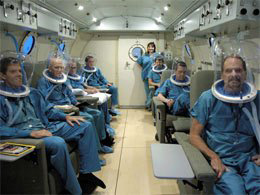Diving Organizations

Virginia Mason Hyperbaric Lab
The laboratory was started in the fall of 1967 by Dr. Merril Spencer, the Director of the research center. The laboratory was started as a result of private research on decompression sickness done by Spence Campbell and aired on KOMO TV as a special documentary by KOMO’s anchor, Bill Brubaker. Dr. Spencer saw the story and offered Spence the opportunity of helping him develop a Diving Physiology research laboratory at Virginia Mason.
Spence was made manager of the Laboratory and moved all his home lab equipment and small decompression chamber to Virginia Mason.
Dr. Spencer was heavily involved in two areas of research: The study of blood flow and the physiology of diving mammals. Together, Dr. Spencer and Spence Campbell developed research projects which covered Blood flow, the diving physiology and diving reflex of aquatic mammals, and the diving physiology of human divers; specifically the prevention of decompression sickness. Within two years the researchers were awarded several research grants from the National Institute of Hearth and other sources.
In the spring of 1968, they conducted a research experiment that changed the way scientists looked at decompression tables as a prevention of decompression sickness. It actually put Doppler sound to early formation of bubbles in the blood of a decompressing diver.
In this case, the diver was a sheep that has a very similar anatomical blood vascular system. Their breakthrough experiment gave rise to a host of national and international studies on vascular gas emboli (bubbles in the blood). Their research also studied the effect of pharmacological agents in the treatment of severe decompression sickness.
Spence left the research center in 1972 to teach a one year Scientific Diver Certification Program at Bellevue Community College and a few years later Dr. Spencer left Virginia Mason to develop his own research center The Institute of Applied Physiology and Medicine.
Dr. Spencer continued studies on the use of the non-invasive Doppler monitor. The instrument and techniques for the prevention of decompression sickness was used effectively to bring the Cobb Seamount diving team from a 5% Bends incidence to a zero occurrence by restricting divers with detected bubble development from participating in repetitive decompression dives.
After 1972, some of the research work was carried on by Dr. Kent Smith and Dave Johansen, and the Laboratory turned more toward Hyperbaric medical applications, but maintained it’s association with the sports diving community as a treatment facility.
